Overview
The instant runoff method for union elections presents significant advantages, such as enhanced voter turnout, minimized wasted votes, and improved representation of diverse candidates. Evidence from various jurisdictions that have adopted this voting system illustrates increased participation rates and heightened voter satisfaction. This demonstrates the method’s effectiveness in cultivating a more inclusive and engaged electoral process. Furthermore, union leadership should consider these compelling benefits as a means to foster greater involvement and representation within their communities.
Introduction
The landscape of union elections is evolving. Innovative voting methods, such as the instant runoff, are gaining traction for their potential to reshape democratic participation. This method not only enhances voter engagement but also addresses critical issues like wasted votes and candidate representation. However, as unions contemplate adopting this approach, pressing questions arise:
- Can the instant runoff truly deliver on its promises of inclusivity and efficiency?
- Are there hidden challenges that might undermine its effectiveness?
Exploring the multifaceted benefits of the instant runoff method reveals a path toward more equitable and representative electoral processes. By examining its potential, union leadership can better understand how this innovative approach could transform their electoral practices, ultimately leading to stronger member engagement and representation.
Votem: Secure Online Voting for Instant Runoff Elections
Votem’s CastIron platform provides a secure and compliant designed specifically for the instant runoff method contests. It meets stringent governance requirements, including NCUA, DOL, ERISA, and SOC 2, ensuring that every ballot is encrypted both in transit and at rest while maintaining an immutable audit trail. This robust security framework is vital for labor unions, which depend on reliable voting procedures to empower their members and uphold democratic principles.
Furthermore, the platform’s mobile-first user experience significantly enhances participation, making it an ideal choice for organizations committed to transparency and fairness. As emphasized by the Office of Labor-Management Standards, safeguarding ballot confidentiality is essential for ensuring equitable processes. Votem’s advanced technology fosters trust and encourages participation among citizens, ultimately reinforcing the democratic process. By integrating such a solution, union leadership can navigate the complexities of modern voting while maintaining integrity and confidence in their electoral processes.

Enhanced Voter Turnout: Boost Engagement with Instant Runoff Voting
The instant runoff method significantly enhances participation by allowing individuals to rank their preferred candidates. This , which employs the instant runoff method, addresses the fear of ‘wasting’ votes, thus encouraging broader engagement in the electoral process. Research shows that jurisdictions implementing the instant runoff method have experienced turnout increases of up to 20%. For example, cities in the Bay Area that adopted IRV witnessed candidates of color winning 62% of races, a notable increase from just 38% prior to its implementation. Furthermore, Alaska’s inaugural instant runoff method election in 2022 revealed that 85% of participants found the system straightforward, indicating high satisfaction rates across diverse demographics.
In addition, Votem’s mobile-first user experience can amplify turnout by as much as three times on launch day, positioning it as a strategic option for organizations aiming to boost electoral participation. Such findings underscore IRV’s potential to effectively engage union members. As union leadership navigates the complexities of electoral participation, adopting the instant runoff method could be a transformative step forward.
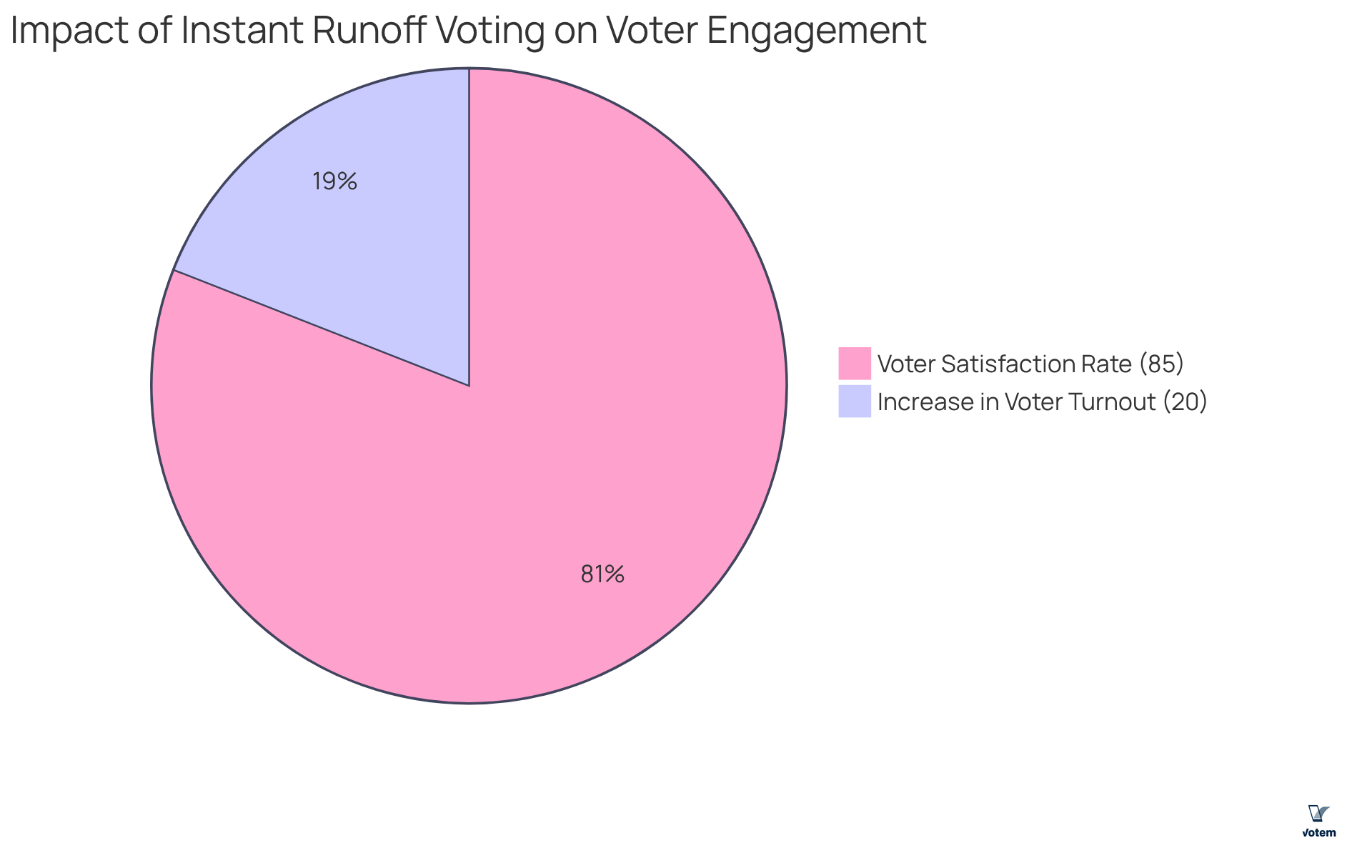
Minimized Wasted Votes: Optimize Election Outcomes with Instant Runoff Voting
The instant runoff method significantly mitigates the issue of wasted votes—a prevalent concern in traditional voting systems, where numerous ballots become irrelevant if a candidate fails to secure victory. By allowing individuals to rank their preferences, the instant runoff method guarantees that even if a person’s top choice is eliminated, their subsequent selections retain importance. This approach not only enhances citizen satisfaction but also fosters more , compelling candidates to engage a wider audience.
In municipalities that have adopted IRV, such as Irmo, South Carolina, there has been a notable increase in participation alongside a reduction in costs associated with runoff elections. Supporters contend that the instant runoff method can yield majority winners without incurring additional expenses, ultimately mirroring the authentic will of the electorate. As Councilman Erik Sickinger aptly stated, IRV is a common-sense upgrade that promotes majority winners while potentially boosting turnout and lowering costs.
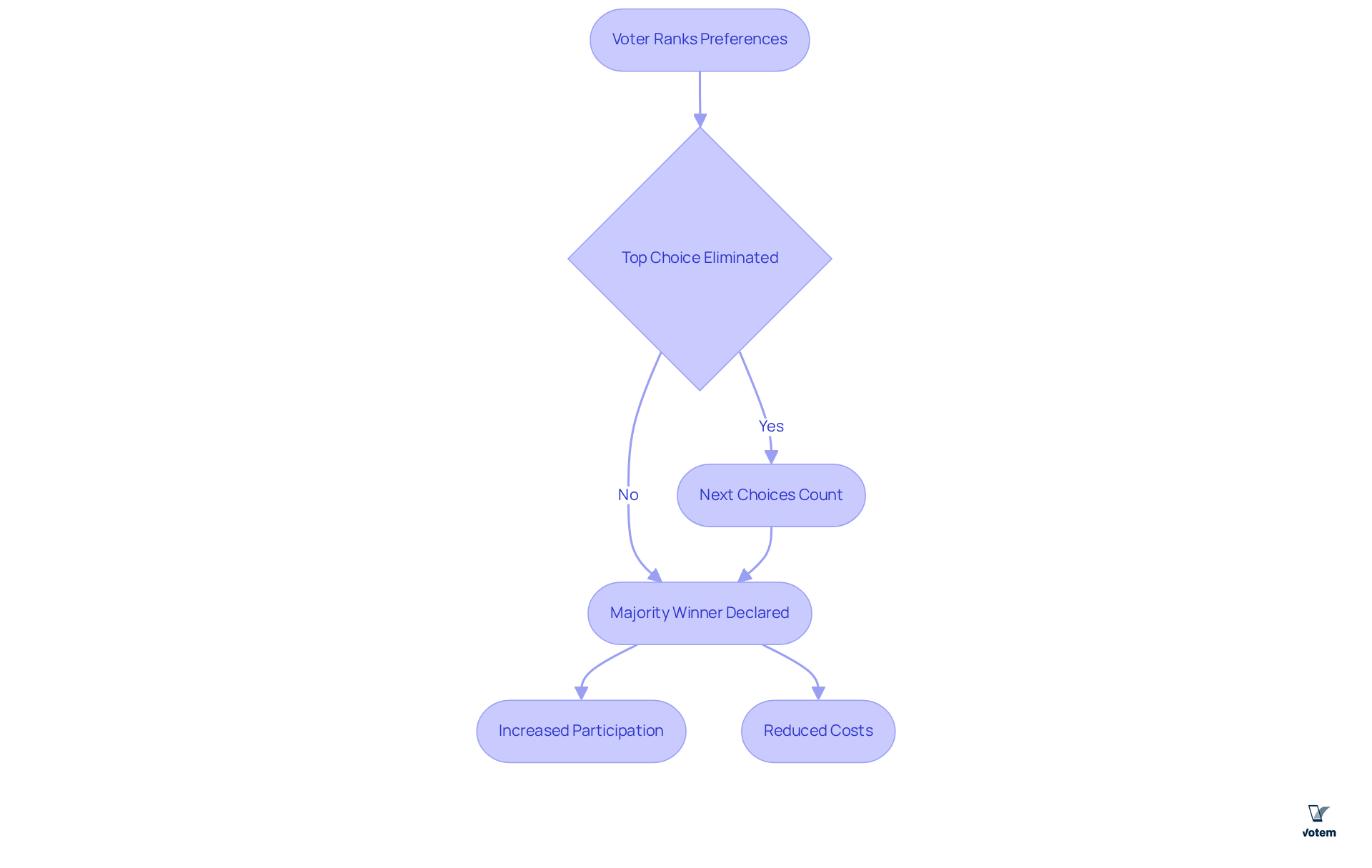
Diverse Candidate Representation: Foster Inclusivity with Instant Runoff Voting
The instant runoff method significantly enhances diverse candidate representation by enabling individuals to rank multiple candidates. This instant runoff method encourages a to engage, as they can still garner support even if they are not the primary choice. Consequently, unions can cultivate leadership that reflects the diversity of their membership, fostering an inclusive environment that effectively addresses the varied needs of all members.
For instance, in recent contests utilizing IRV, candidates of color have seen a notable increase in their vote share, with studies indicating they enjoy a 15% advantage compared to their white counterparts. In Alaska’s inaugural ranked choice voting contest in 2022, approximately 55% of Alaska Native participants placed Mary Peltola first in the special contest, which surged to 75% in the general contest. This illustrates how the instant runoff method can enhance representation for minority candidates.
Such a shift not only empowers underrepresented groups but also enriches the decision-making processes within unions, ensuring that leadership mirrors the entire membership base. Furthermore, the instant runoff method encourages positive campaigning, as candidates strive to attract a broader electorate, cultivating a collaborative political environment.
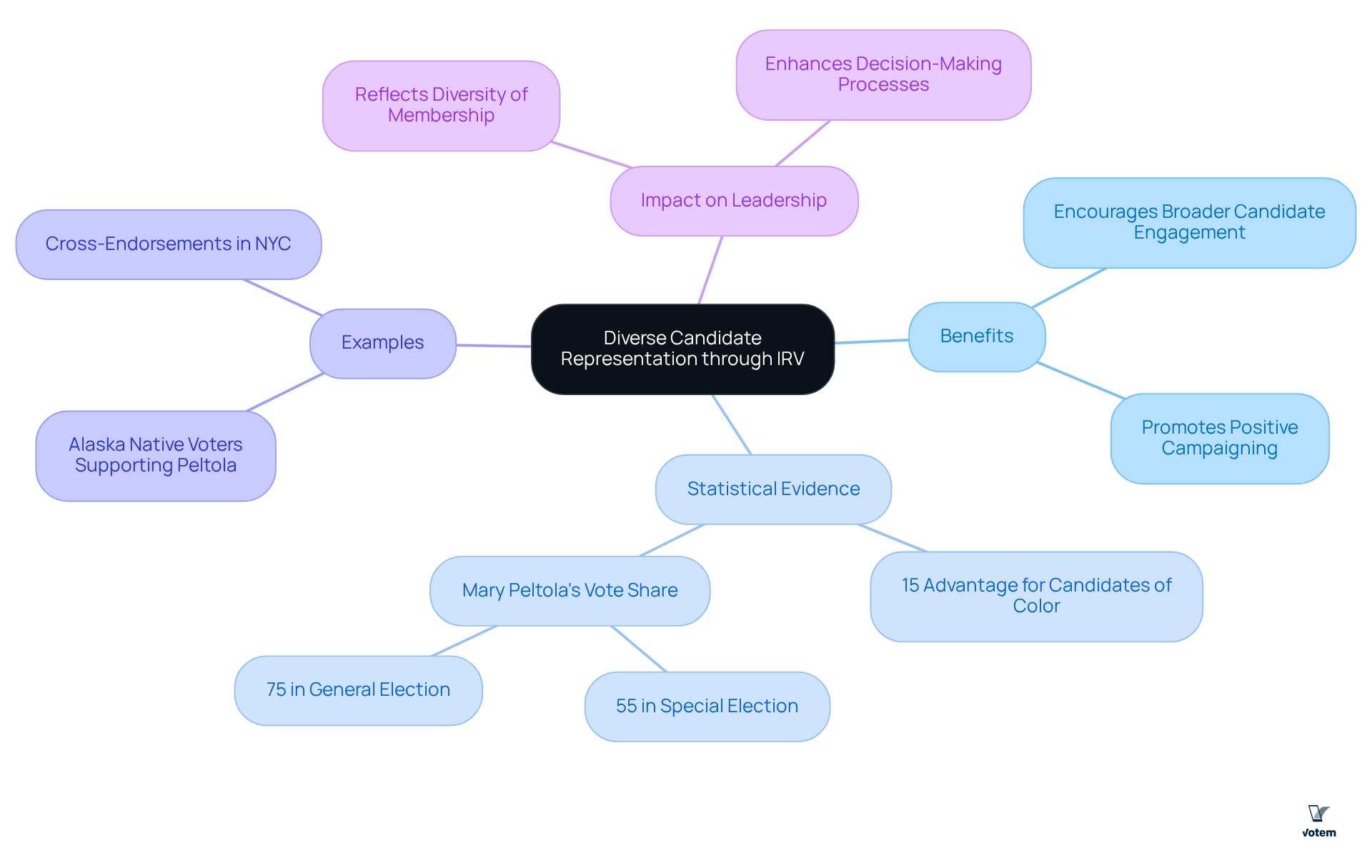
Reduced Spoiler Effect: Strengthen Election Integrity with Instant Runoff Voting
The spoiler effect arises when similar candidates divide the vote, ultimately resulting in the election of a less preferred candidate. This phenomenon can . The instant runoff method serves as an effective remedy by allowing voters to rank their preferences. Should a voter’s top choice be eliminated, their vote seamlessly transfers to their next preferred candidate. This ensures that the eventual winner enjoys broad support, reflecting the true will of the electorate. Moreover, this mechanism not only enhances the integrity of the election but also empowers candidates to participate without the fear of inadvertently aiding their opponents. By embracing the instant runoff method, we can foster a more inclusive and representative electoral process.
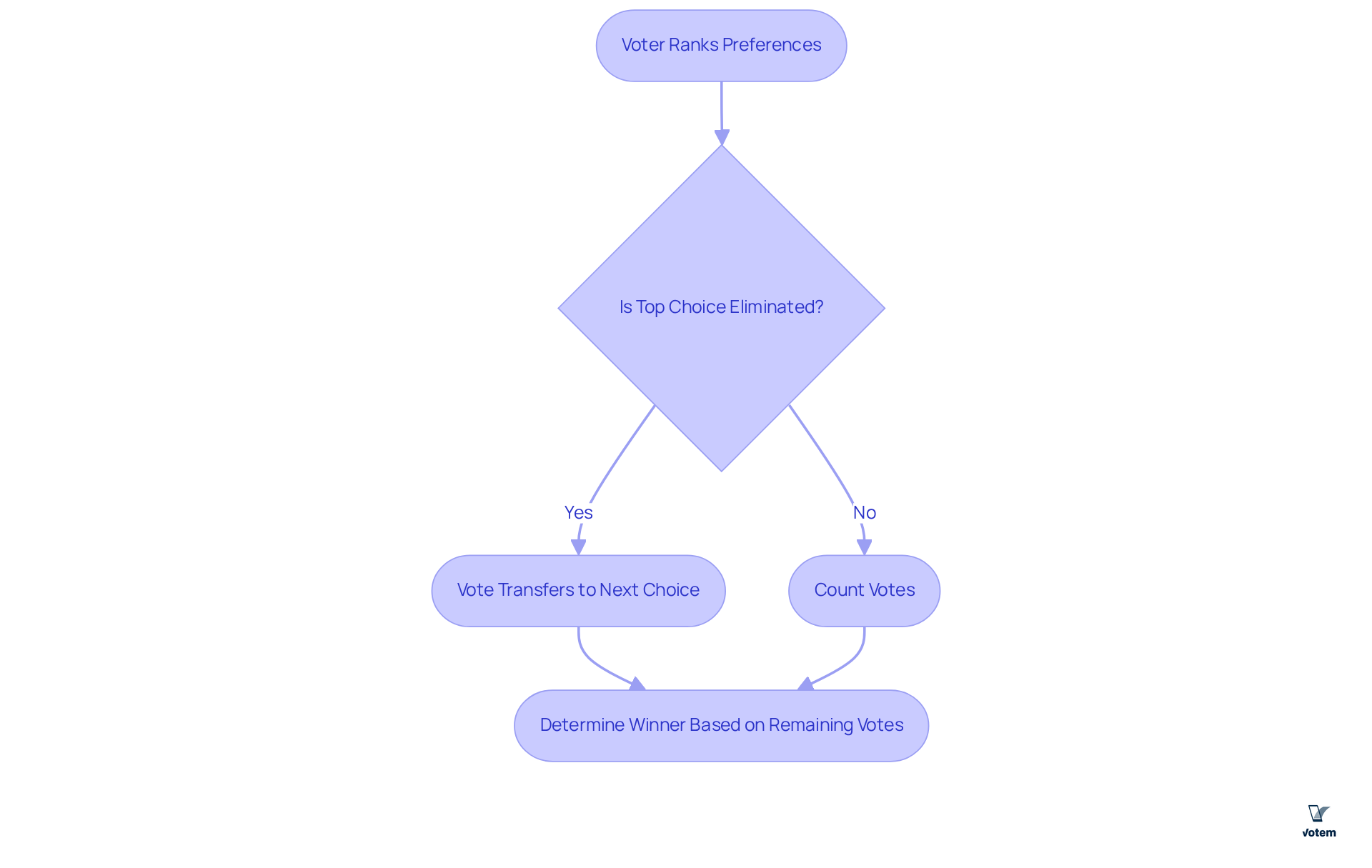
Encouraged Civil Campaigning: Promote Positive Elections with Instant Runoff Voting
The instant runoff method significantly encourages civil campaigning by enabling candidates to appeal to a broader audience. Candidates, aware that they can gain second-choice votes, are motivated to avoid negative tactics and instead focus on coalition-building and constructive dialogue. This shift towards not only enhances the electoral atmosphere but also cultivates respect among candidates and their supporters.
Historical examples from jurisdictions like New York City and Maine that have adopted ranked-choice voting demonstrate that candidates tend to prioritize their vision for the constituency over attacking opponents. Research shows that in contests utilizing the instant runoff method, candidates engage in more respectful dialogue, resulting in a more robust political atmosphere.
Nicole Sanchez, President of Better Ballot SC, emphasizes this point, stating, “Voters won’t rank a candidate who is attacking their top pick.” This change in candidate behavior is essential for promoting collaboration and minimizing divisiveness in voting, ultimately enhancing the democratic process.
Furthermore, the implementation of the instant runoff method can lead to significant cost savings, such as the estimated $200,000 per election for Charleston, making it a practical choice for municipalities.
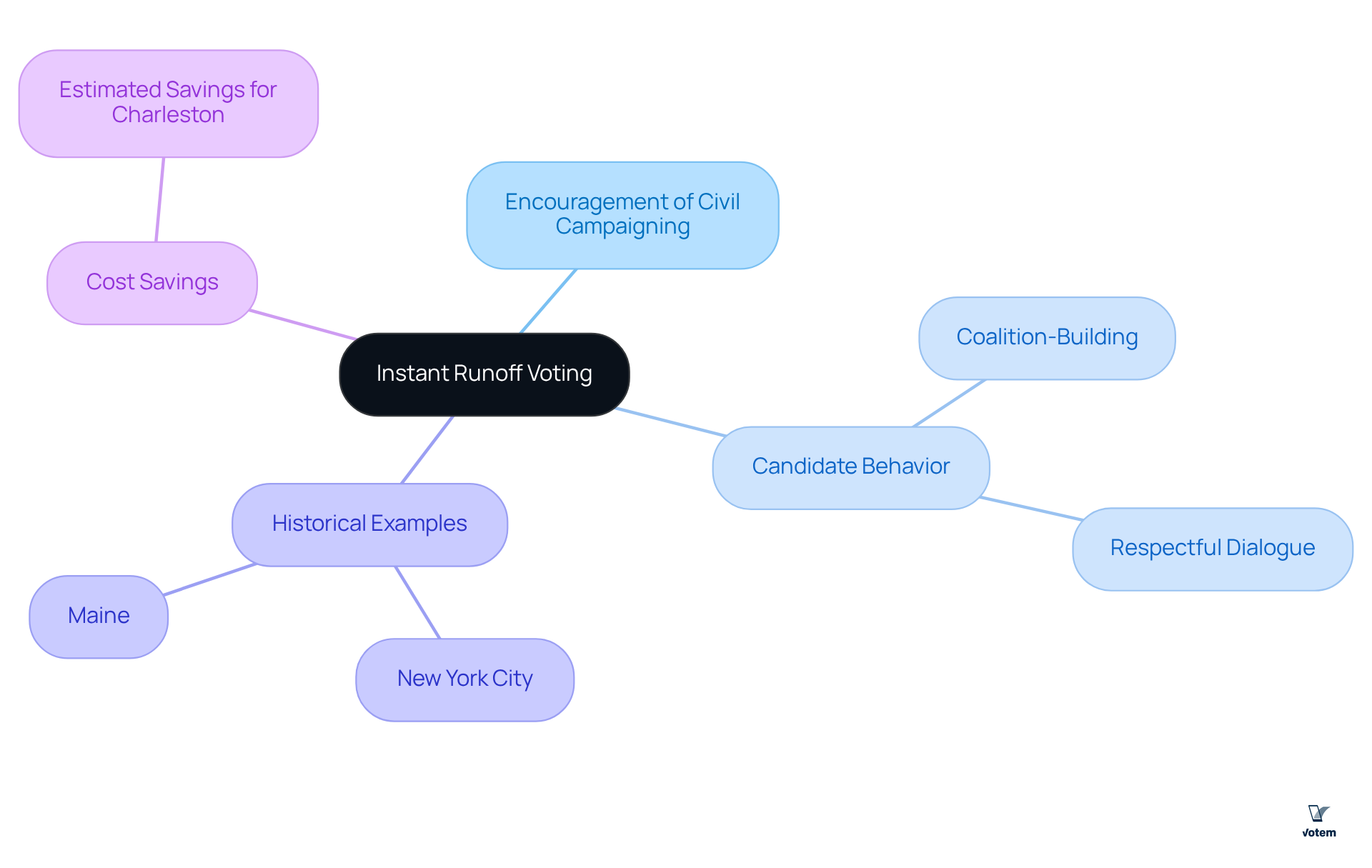
Flexibility in Voting Preferences: Adapt Instant Runoff Voting to Your Needs
The instant runoff method empowers organizations to tailor their electoral processes to meet specific needs. For example, unions can implement the instant runoff method in various formats, such as online participation through Votem’s CastIron platform, which enhances security via ballot encryption and an immutable audit trail, or through traditional in-person ballots. This versatility guarantees participation from all members, irrespective of their circumstances, thus and satisfaction.
Research indicates that the instant runoff method can significantly boost participation rates; some unions have reported turnout on launch day being up to three times higher when utilizing Votem’s mobile-first ballot solutions. Moreover, IRV has the potential to improve representation for marginalized groups, promoting a more inclusive and accessible electoral process. By customizing the electoral experience, unions can enhance member engagement and instill greater confidence in their leadership.
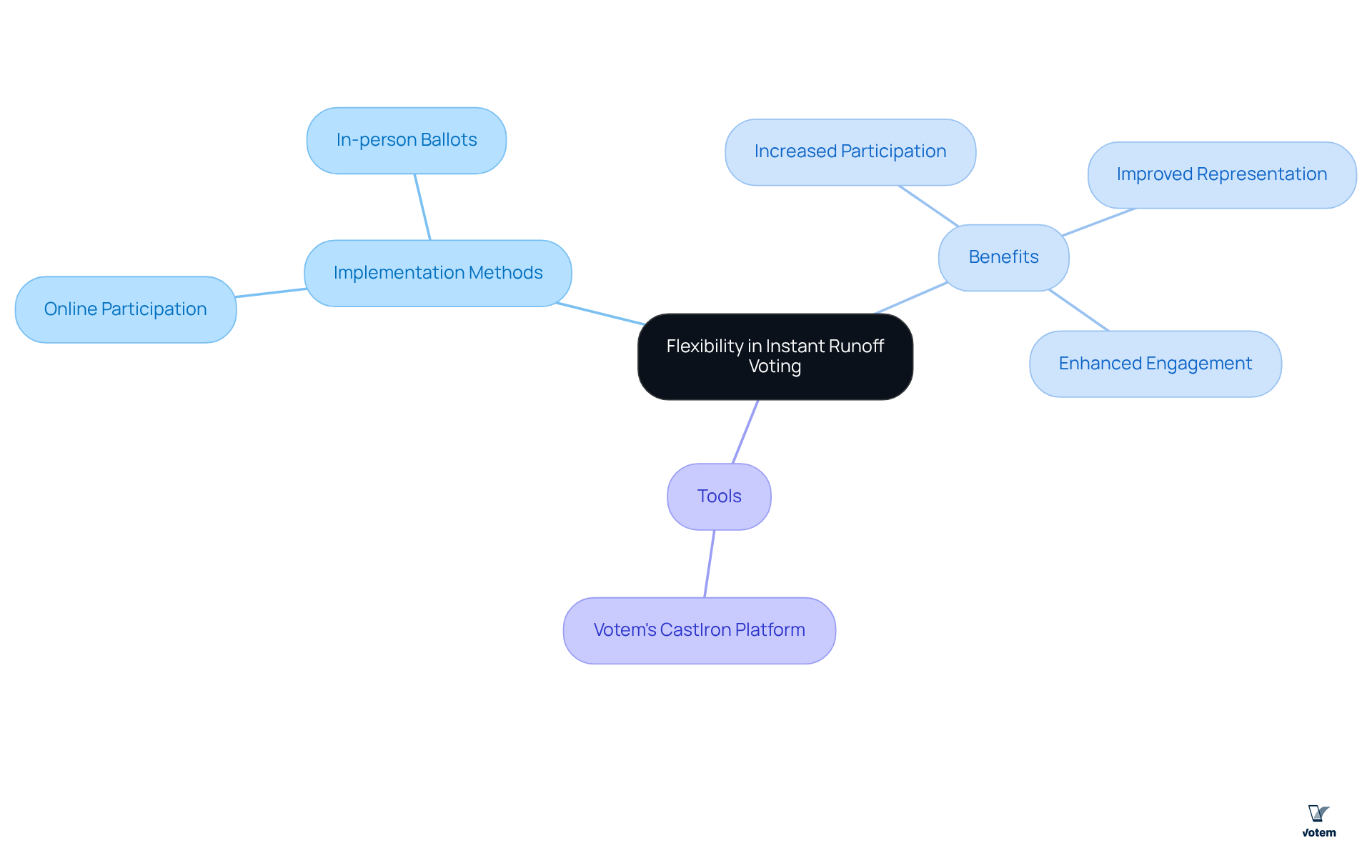
Transparency in Voting: Build Trust with Instant Runoff Voting
Clarity in the electoral process is essential for establishing confidence among participants. Instant runoff method (IRV) systems often incorporate clear procedures for counting and reporting results, which can be effectively communicated to union members. By ensuring that all steps are visible and verifiable, unions can foster confidence in the electoral process, encouraging greater participation and engagement from their members.
Information indicates that when citizens comprehend the electoral procedure, they are more inclined to engage, reinforcing the notion that clear systems are crucial for establishing trust and ensuring the integrity of elections. For instance, the mobile-first user experience can boost voter turnout by up to three times on launch day, underscoring the impact of transparency on engagement.
However, concerns regarding the complexity of the instant runoff method, as articulated by Senator Ken Rozenboom, highlight the necessity for robust public education initiatives to ensure that all members are informed and confident in the electoral process.
Successful case studies from unions that have established clear electoral procedures demonstrate the , ultimately leading to increased trust and participation.
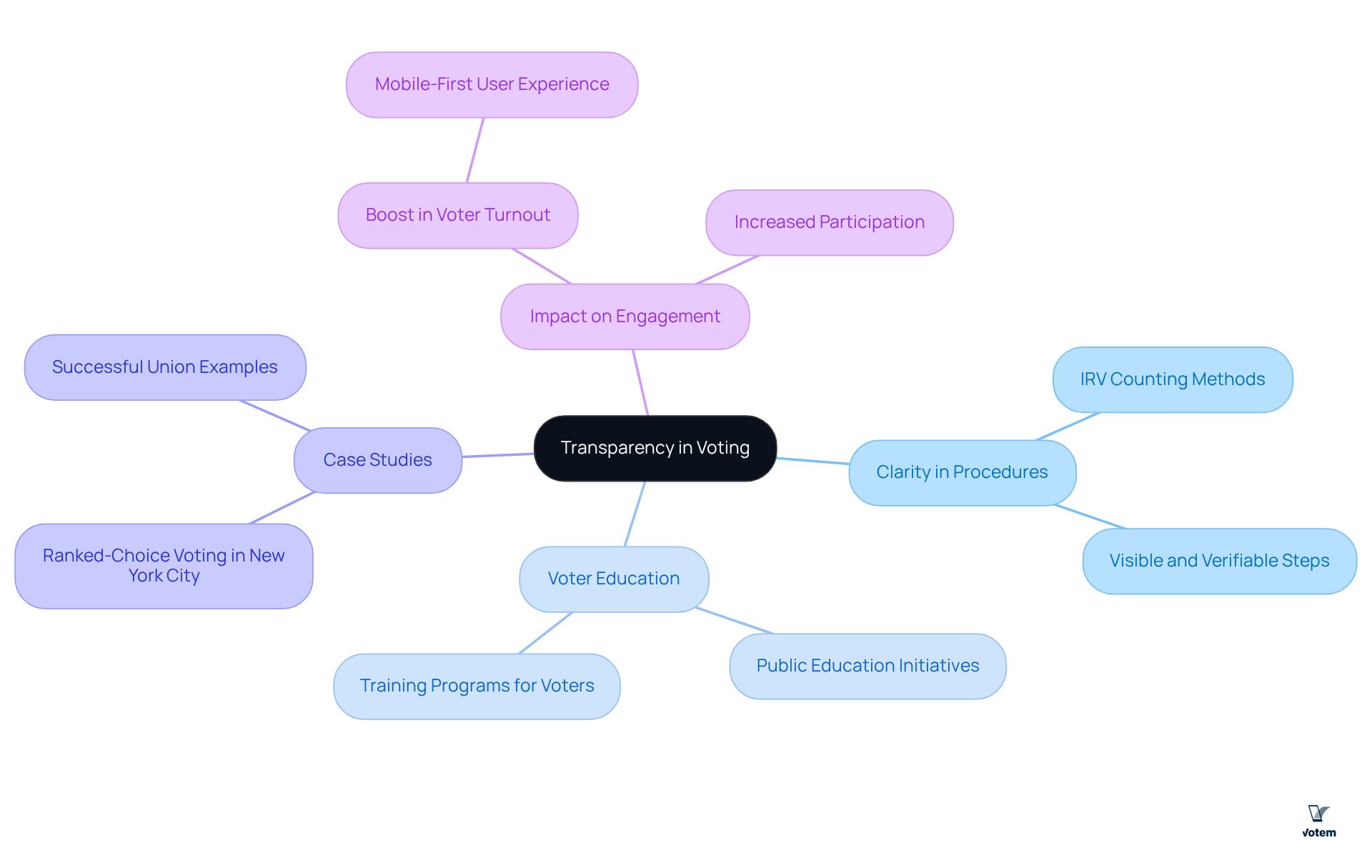
Efficient Election Processes: Streamline Operations with Instant Runoff Voting
The instant runoff method significantly streamlines voting procedures by consolidating multiple rounds into a single event. This approach not only reduces the administrative burden on unions but also allows for more effective resource allocation. Studies indicate that ranked-choice voting (RCV) contests correlate with a 10-point increase in voter participation, underscoring the effectiveness of this method. Unions adopting IRV report a marked reduction in the time and effort required for , enabling a greater focus on member engagement and other essential activities.
Furthermore, Votem’s platform seamlessly manages the entire voting process—from registration to counting—ensuring compliance with regulations while enhancing the overall electoral experience for both organizers and participants. The platform encrypts every ballot in transit and at rest, publishes an immutable audit trail, and exports AES-256 vote packets for offline archival, reinforcing its reliability and security. As Councilman Gabriel Penfield articulated, ‘The instant runoff method guarantees that contests mirror the genuine desires of the public by enabling individuals to rank candidates, ensuring majority backing without expensive runoffs.’
The effectiveness of IRV, combined with Votem’s technology, empowers unions to conduct polls that are not only secure but also economical. This ultimately leads to increased participation and satisfaction among constituents, illustrating a powerful solution for union leadership facing the challenges of modern electoral processes.
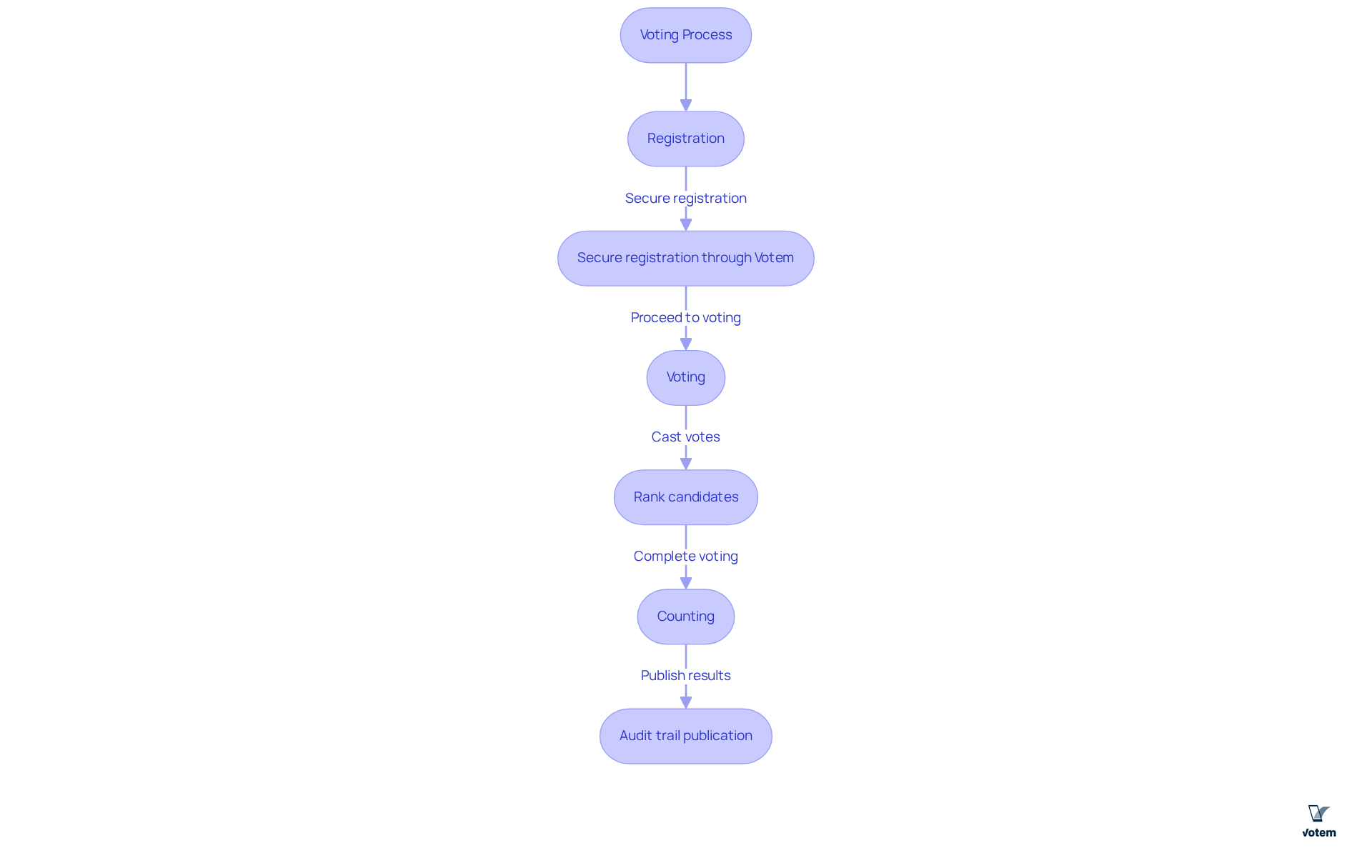
Proven Success: Learn from Historical Adoption of Instant Runoff Voting
The historical adoption of the instant runoff method across various jurisdictions has consistently demonstrated its effectiveness in enhancing electoral outcomes. Take, for instance, New York City, which embraced ranked-choice voting during its 2021 Democratic primary. Here, voters were allowed to rank up to five of the 13 candidates on the ballot, resulting in a notable increase in participation compared to previous contests. Many voters expressed satisfaction with the ability to rank candidates, highlighting a desire for more engagement in the electoral process. Likewise, Alaska’s implementation of the instant runoff method in its 2022 elections facilitated the reelection of moderate candidates such as Lisa Murkowski, showcasing a preference for candidates who resonate with a broader electorate. Notably, Alaska recorded the third highest primary turnout in the U.S. in 2022, underscoring the effectiveness of the instant runoff method in enhancing electoral participation.
Statistics reveal that jurisdictions employing the instant runoff method often experience heightened satisfaction among voters. In San Francisco, where ranked-choice voting has been established since 2004, voters reported feeling more represented and engaged in the electoral process. Furthermore, studies suggest that the instant runoff method (IRV) can significantly reduce the costs associated with traditional runoff elections, which can exceed $1 million per cycle, all while increasing participation rates.
These success stories serve as a compelling case for unions to effectively into their electoral processes, fostering a more representative and engaged membership. By drawing lessons from these examples, union leadership can refine their electoral strategies, ultimately leading to improved outcomes and greater member satisfaction.
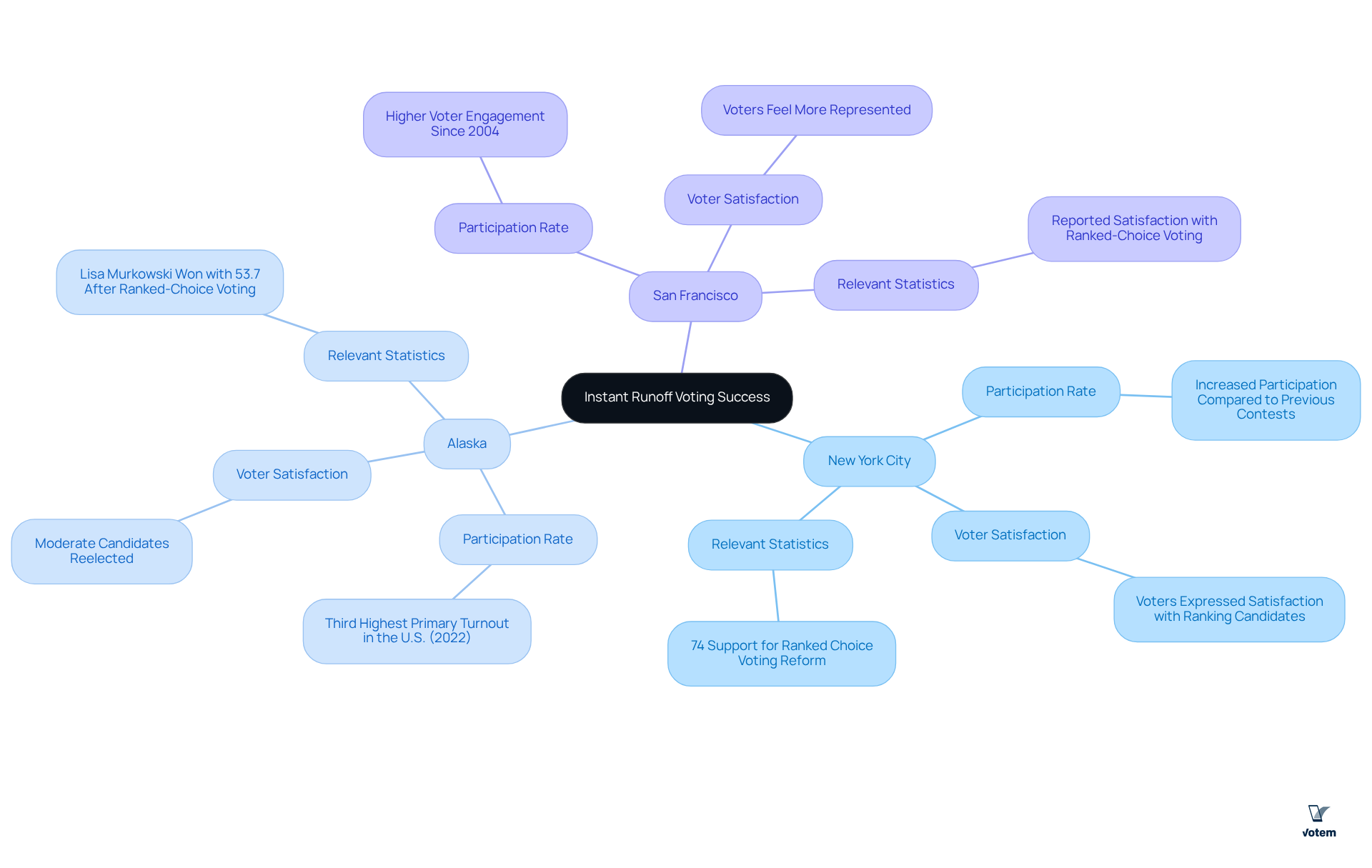
Conclusion
The instant runoff method offers a transformative approach to union elections, significantly enhancing democratic engagement and ensuring that every member’s voice is heard. By enabling voters to rank candidates, this method minimizes wasted votes and promotes inclusivity and diverse representation within union leadership. Furthermore, the integration of secure online voting platforms, such as Votem, strengthens this process, ensuring that elections are conducted transparently and efficiently.
Key insights from the article reveal that instant runoff voting can lead to increased voter turnout, with jurisdictions reporting participation boosts of up to 20%. This method also fosters civil campaigning, encouraging candidates to appeal to a broader audience rather than resorting to negative tactics. Historical examples from cities like New York and states like Alaska illustrate the success of instant runoff voting in enhancing electoral outcomes and member satisfaction.
Ultimately, adopting the instant runoff method transcends mere procedural change; it embodies a commitment to fostering a more inclusive and representative electoral process. Unions are encouraged to embrace this innovative approach, leveraging its benefits to strengthen their democratic practices and engage their members more effectively. By prioritizing transparency, security, and voter participation, union leadership can create a more vibrant and representative electoral landscape, paving the way for a brighter future.
Frequently Asked Questions
What is Votem’s CastIron platform?
Votem’s CastIron platform is a secure and compliant online voting solution designed specifically for instant runoff elections. It ensures that every ballot is encrypted both in transit and at rest, while also maintaining an immutable audit trail.
What governance requirements does the CastIron platform meet?
The CastIron platform meets stringent governance requirements, including those set by NCUA, DOL, ERISA, and SOC 2.
Why is the security framework of Votem’s platform important for labor unions?
The robust security framework is vital for labor unions as it ensures reliable voting procedures that empower members and uphold democratic principles.
How does the mobile-first user experience of Votem’s platform enhance voter participation?
The mobile-first user experience significantly enhances participation by making the voting process more accessible, which is ideal for organizations committed to transparency and fairness.
What impact does the instant runoff voting method have on voter turnout?
The instant runoff voting method enhances participation by allowing individuals to rank their preferred candidates, addressing the fear of ‘wasting’ votes and encouraging broader engagement. Research shows that jurisdictions implementing this method have experienced turnout increases of up to 20%.
Can you provide an example of increased voter turnout due to instant runoff voting?
In the Bay Area, cities that adopted instant runoff voting saw candidates of color winning 62% of races, an increase from 38% prior to its implementation.
What was the feedback from participants in Alaska’s first instant runoff election?
In Alaska’s inaugural instant runoff election in 2022, 85% of participants found the system straightforward, indicating high satisfaction rates across diverse demographics.
How does instant runoff voting minimize wasted votes?
Instant runoff voting mitigates the issue of wasted votes by allowing individuals to rank their preferences, ensuring that if a person’s top choice is eliminated, their subsequent selections still hold importance.
What benefits have municipalities experienced by adopting instant runoff voting?
Municipalities that have adopted instant runoff voting have seen increased participation and reduced costs associated with runoff elections, yielding majority winners without incurring additional expenses.
How does instant runoff voting promote majority winners?
Instant runoff voting promotes majority winners by allowing voters to express their preferences more fully, which can lead to more representative outcomes and compel candidates to engage a wider audience.
List of Sources
- Votem: Secure Online Voting for Instant Runoff Elections
- online elections for unions (https://simplyvoting.com/online-elections-for-unions)
- simplyvoting.com (https://simplyvoting.com/countries-and-us-states-using-online-voting)
- CDW Issues Report on the Dangers of Online Voting in Union Representation Elections – Coalition for a Democratic Workplace (https://myprivateballot.com/2022/07/12/cdw-issues-report-on-the-dangers-of-online-voting-in-union-representation-elections)
- Union Voting: The Election Platform for Unifying Your Union Members! – ElectionBuddy (https://electionbuddy.com/customers/unions)
- Electing Union Officers Using Remote Electronic Voting Systems (https://dol.gov/agencies/olms/compliance-assistance/tips/remote-electronic-voting-systems)
- Enhanced Voter Turnout: Boost Engagement with Instant Runoff Voting
- Does ranked choice Voting Increase voter turnout and mobilization? (https://sciencedirect.com/science/article/pii/S026137942400074X)
- Ranked-Choice Voting Gains Momentum Nationwide • Stateline (https://stateline.org/2021/03/12/ranked-choice-voting-gains-momentum-nationwide)
- The Impact of Instant Runoff Voting on Representation for Women and People of Color | Unite America (https://uniteamerica.org/articles/the-impact-of-instant-runoff-voting-on-representation-for-women-and-people-of-color)
- Runoffs See 63% Decline in Voter Turnout, Report Finds – FairVote (https://fairvote.org/press/runoffs-see-63-decline-in-voter-turnout-report-finds)
- Minimized Wasted Votes: Optimize Election Outcomes with Instant Runoff Voting
- Georgia runoff sees turnout drop 10%. Ranked choice voting can help. – FairVote (https://fairvote.org/georgia-runoff-sees-turnout-drop-10-ranked-choice-voting-can-help)
- Irmo passes instant runoff voting resolution (https://wach.com/news/local/irmo-passes-instant-runoff-voting-resolution)
- Instant Runoff Voting In the News (https://betterballotsc.org/news)
- House, Senate prohibit instant runoff voting amid lawsuit by Memphis politicos against state • Tennessee Lookout (https://tennesseelookout.com/2022/02/15/house-senate-prohibit-instant-runoff-voting-amid-lawsuit-by-memphis-politicos-against-stat)
- Diverse Candidate Representation: Foster Inclusivity with Instant Runoff Voting
- How ranked-choice voting helps women and people of color (https://19thnews.org/2021/06/how-ranked-choice-voting-elevates-women-and-people-of-color-seeking-office)
- Ranked choice voting elections benefit candidates and voters of color: 2024 update – FairVote (https://fairvote.org/report/communities-of-color-2024)
- attheu.utah.edu (https://attheu.utah.edu/facultystaff/ranked-choice-voting-gives-voice-to-diverse-electorate)
- The Impact of Instant Runoff Voting on Representation for Women and People of Color | Unite America (https://uniteamerica.org/articles/the-impact-of-instant-runoff-voting-on-representation-for-women-and-people-of-color)
- Reduced Spoiler Effect: Strengthen Election Integrity with Instant Runoff Voting
- Ranked Choice Voting (https://ncsl.org/elections-and-campaigns/ranked-choice-voting)
- Opinion: Ranked choice voting ends the election ‘spoiler’ problem (https://ctmirror.org/2023/08/16/ct-ranked-choice-voting-spoiler-problem-election-campaigns)
- Instant runoffs offer states a chance to increase security and save money (https://thehill.com/opinion/congress-blog/3559483-instant-runoffs-offer-states-a-chance-to-increase-security-and-save-money)
- Ranked choice voting is on the ballot in several states (https://newsnationnow.com/politics/ranked-choice-voting-states)
- Instant Runoffs — Unite America (https://uniteamerica.org/instant-runoffs)
- Encouraged Civil Campaigning: Promote Positive Elections with Instant Runoff Voting
- Sanchez: Instant runoff voting could fix broken election system – Charleston City Paper (https://charlestoncitypaper.com/2023/08/20/sanchez-instant-runoff-voting-could-fix-broken-election-system)
- Ranked-Choice Voting Gains Momentum Nationwide • Stateline (https://stateline.org/2021/03/12/ranked-choice-voting-gains-momentum-nationwide)
- knowablemagazine.org (https://knowablemagazine.org/content/article/society/2021/can-ranked-choice-voting-heal-our-poisoned-politics)
- NEW for 12/15: On instant-runoff voting and encouraging news – Statehouse Report (https://statehousereport.com/2023/12/15/instant-runoff-voting-encouraging-news)
- Flexibility in Voting Preferences: Adapt Instant Runoff Voting to Your Needs
- Instant runoffs voting bill introduced in Georgia House (https://gpb.org/news/2023/02/03/instant-runoffs-voting-bill-introduced-in-georgia-house)
- Instant runoff voting | MIT Election Lab (https://electionlab.mit.edu/research/instant-runoff-voting)
- Instant Runoff Voting News: IRV a Hit in Twin Cities, in Media, on Campus and in the UK (https://huffpost.com/entry/instant-runoff-voting-new_b_397755/amp)
- Instant Runoff Voting Could Stop Expensive, Low-Turnout Runoff Elections – Citizens Union (https://citizensunion.org/portfolio-item/instant-runoff-voting-could-stop-expensive-low-turnout-runoff-elections)
- Electeds & Advocates Call For Instant Runoff Voting To Replace Runoff Election At Polls – Citizens Union (https://citizensunion.org/portfolio-item/electeds-advocates-call-for-instant-runoff-voting-to-replace-runoff-election-at-polls)
- Transparency in Voting: Build Trust with Instant Runoff Voting
- Kansas Bans Ranked-Choice Voting Scheme – Election Transparency Initiative (https://electiontransparency.org/2025/04/08/kansas-bans-ranked-choice-voting-scheme)
- Senate Republicans want to ban ranked-choice voting. It’s not used in any Iowa elections (https://desmoinesregister.com/story/news/politics/2025/03/19/iowa-legislature-senate-republicans-move-to-ban-ranked-choice-voting-in-elections/82542839007)
- Ranked-Choice Voting Gains Momentum Nationwide • Stateline (https://stateline.org/2021/03/12/ranked-choice-voting-gains-momentum-nationwide)
- House, Senate prohibit instant runoff voting amid lawsuit by Memphis politicos against state • Tennessee Lookout (https://tennesseelookout.com/2022/02/15/house-senate-prohibit-instant-runoff-voting-amid-lawsuit-by-memphis-politicos-against-stat)
- Gadzooks: Ranked-choice voting restored trust (https://santafenewmexican.com/news/local_news/gadzooks-ranked-choice-voting-restored-trust/article_798bd7d6-681c-4475-b45a-7ee5774a0b60.html)
- Efficient Election Processes: Streamline Operations with Instant Runoff Voting
- Irmo passes instant runoff voting resolution (https://wach.com/news/local/irmo-passes-instant-runoff-voting-resolution)
- Does ranked choice Voting Increase voter turnout and mobilization? (https://sciencedirect.com/science/article/pii/S026137942400074X)
- Possible Changes at the Polls (https://abcnews4.com/news/local/john-tecklenburg-instant-runoff-voting-bill-proposed-to-efficiently-choose-local-leaders-south-carolina-poltical-news-wciv-2023)
- Research and data on RCV in practice – FairVote (https://fairvote.org/resources/data-on-rcv)
- Instant Runoff Voting In the News (https://betterballotsc.org/news)
- Proven Success: Learn from Historical Adoption of Instant Runoff Voting
- The future of the instant runoff election reform | Brookings (https://brookings.edu/articles/the-future-of-the-instant-runoff-election-reform)
- Georgia legislators exploring ranked-choice voting (https://thefulcrum.us/instant-runoff-voting)
- Austin Voters Pass Ranked Choice Voting, Joining Voters First Movement | Unite America (https://uniteamerica.org/articles/austin-voters-pass-instant-runoff-voting)
- pewresearch.org (https://pewresearch.org/short-reads/2021/06/29/more-u-s-locations-experimenting-with-alternative-voting-systems)

